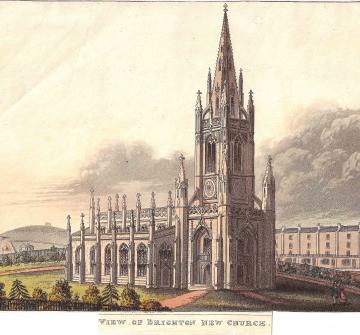St Peter's Church, London Road, City of Brighton and Hove

St. Peter's Church was designed by Charles Barry. It was the third of his churches in this style but is considered to be the most elegant. In the City of brighton and Hove it plays a key role as a landmark at the north end of the North Steine and is visible from the Royal Pavilion. When the gardens were managed to present an eye-catching series of displays between the two buildings, a task managed by a series of local government bodies from the early nineteenth century until the 1970s, the church helped to give the whole area a sense of entity. It also stimulated the development of good quality terraced housing up the sides of the Steine, adding to the wonderful Georgian legacy that had already been built, some of which survives.
By the time that the parish of Brighton had seriously considered building a daughter church, the population of the parish, into which the resort was packed, had reached 24,000. Anglican worship was served by a small medieval church called St Nicholas of Myra which was packed with Georgian pews and galleried and by several privately owned chapels of ease. Land was given by Thomas Read Kemp and his fellow owners of the pastures and meadows of Brighton. The parish formed a church building committee which held a competition for a design for a new church. They approved Barry's design and William Ranger began work at the end of 1823. progress was slow and the church was consecrated in 1828. Built of Portland stone, it cost £21,865 and was one of the most expensive churches built by a parish in this period. The tower was designed by Barry to provide elegant stairs to the galleries which have been removed.
The elegant north (liturgical west) end was lost when Somers Clarke Jnr and J.T. Micklethwaite extended the nave and added a deep chancel in 1899-1906.
To find out more see Sue Berry 'The construction of St. Peter's Church Brighton c1818-1835' Sussex Archaeological Collections Vol. 148 (2010)
Content derived from research undertaken as part of the Victoria County History project
Content derived from research undertaken as part of the Victoria County History project

